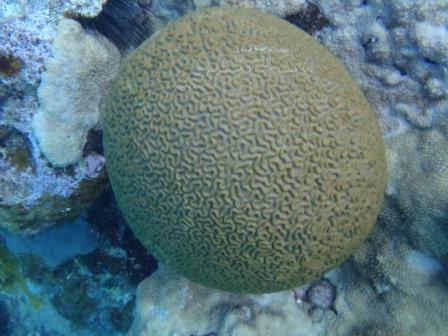Darwin's Paradox

VulcanSpirit
Richard & Alison Brunstrom
Tue 29 Mar 2011 12:29
|
Darwin's first monograph, 'The Structure and
Distribution of Coral Reefs' appeared in 1842, some years after his voyage
in the Beagle; his paradox was the fact that the reefs teemed with life, despite
being surrounded by tropical waters providing very little nutrient - "oases
in the desert of the ocean".
Tropical seas are startling clear precisely because
they provide so little nutrient. The surface water is warmed by the sun and
stays floating at the surface, separated from the denser colder water below by a
stable thermocline; little mixing takes place. Anything which dies in the
surface layer sinks through the thermocline and the products of its decay and
decomposition are not available at the surface. This keeps the surface water
clear - but relatively sterile. How, therefore, have coral reefs become amongst
the most diverse ecosystems on the planet, home to 25% of all marine species
despite covering only 0.1% of the world's ocean surface?
The answer lies principally with the coral and its
quite extraordinary symbiosis (a mutually beneficial relationship) with
tiny unicellular algae called zooxanthellae. Reef
building corals evolved in the Tertiary, about 250 million years
ago. They are small sessile colonial animals closely related to
jellyfish and sea anemones. The individuals are called polyps (which look very
like a tiny sea anemone), and it is their ability to deposit calcium
carbonate (the same stuff that makes snail shells, limestone and
chalk) which enables them to build reefs, growing vertically at 3-5mm per
year. The coral polyps' bodies contain huge populations of zooxanthellae
(about 1million per cubic centimetre). The coral provides the algae with a
constant supply of carbon dioxide and nitrogen required for photosynthesis and
the zooxanthellae provide the coral with the products of photosynthesis
(glucose, glycerol and amino acids) which provide about 90% of the corals energy
needs. Neither can survive without the other.These reefs trap nutrients,
preventing them being lost to the sea floor and providing a resource base
for other animals and plants (some of which also deposit calcium carbonate to
contribute to he reef). The complex interdependent ecosystem which evolves
provides the resolution of Darwin's Paradox. And the resulting structures can be enormous - witness the Australian
Great Barrier reef, visible from space. The Great Orme in North Wales is a nice
(small!) example, for those that know it. I find it truly wonderful that such
tiny animals, given sufficient time, can build such vast
structures.
Photographing the reef corals is difficult. The
major problem, when snorkelling, is focus. Focus distance becomes critical
in close-up photography, but when swimming it is very difficult to maintain
position - especially since you cannot hang on to anything in case you
damage it (corals are surprisingly fragile, considering that they are made of
stone), or it stings you (some corals have a powerful sting), or you get
painfully spiked by a large sea urchin. But here are a couple of shots I managed
to get off Virgin Gorda in the BVI. I hope and expect that I'll get better with
more practice.
 This one (above) is a brain coral, Diplora
strigosa, so called for obvious reasons. It is about half a metre in
diameter and about a metre under the surface. They can grow to 2m in diameter.
The coral polyps live in little pits in the valleys between the ridges. There
are several other species of brain coral, each with a diagnostic ridge
pattern.
The picture below is looking down on a metre-high
colony of, I think, boulder star coral Monastraea annularis. I'm
not entirely sure because there are over 1000 species of coral and I'm a novice
at their identification - and this particular species is extremely variable. The
individual polyps are out, looking like pinheads, sifting the water for
phytoplankton to eat and recycle. Between the living brown coral you can see
white limestone exposed - reef which this colony has built.
 More lizard photos following shortly Arthur,
because pictures of the same people eating yet another meal in yet another beach
restaurant on yet another island are just sooo boring.
|